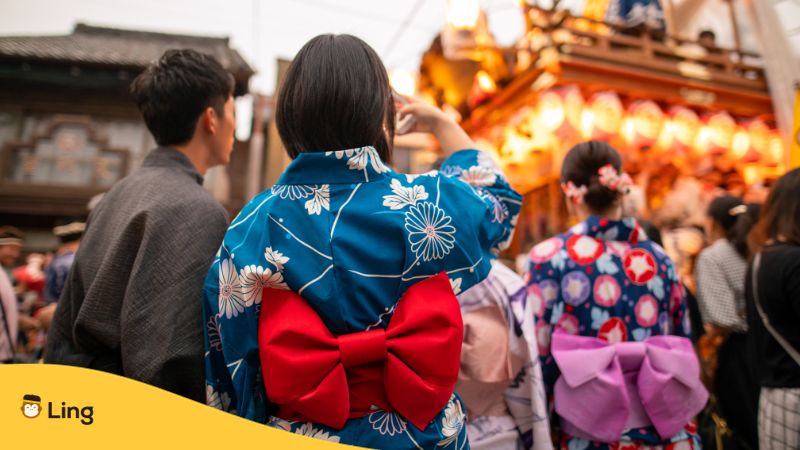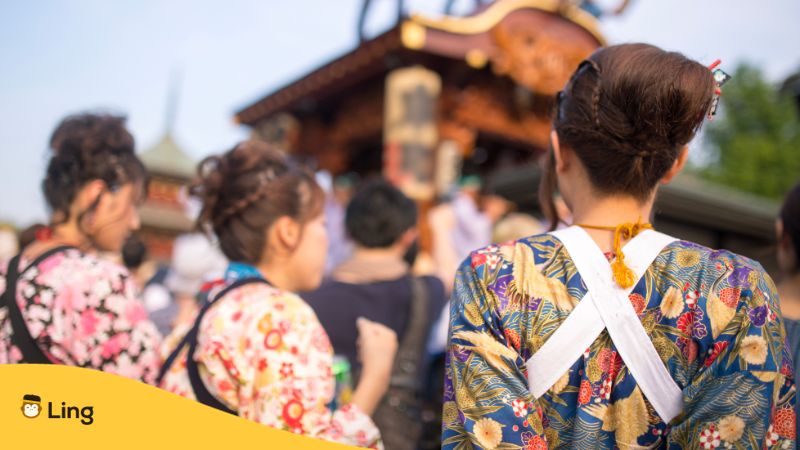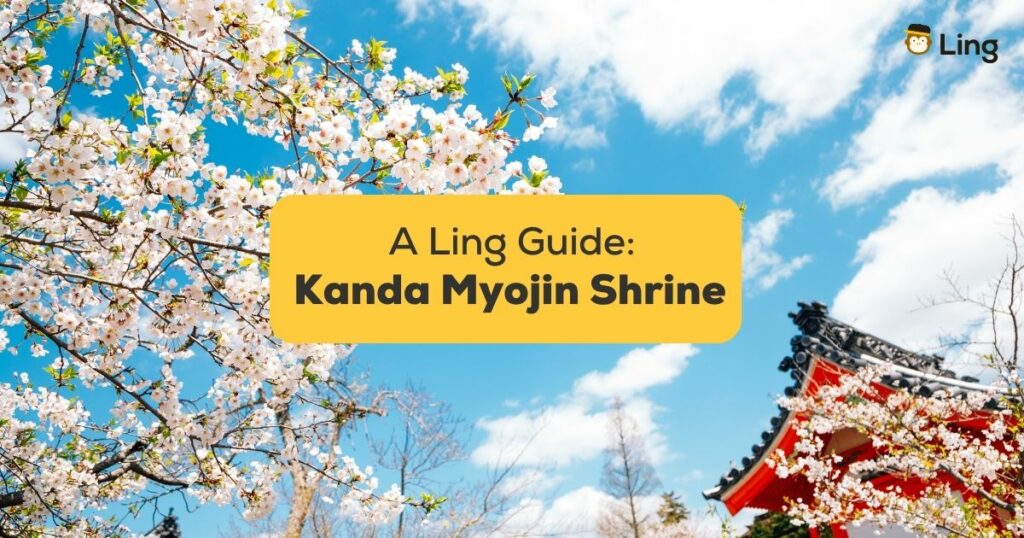Slap bang in the middle of Tokyo’s office and electronics district sits a 1300-year-old portal into mystical ancient Japan – Kanda Myojin Shrine (神田明神). Yep, this iconic Shinto sanctuary dates all the way back to 730 AD amidst the futuristic skyscrapers! Pretty cool, right?
Originally constructed when Tokyo was still quaint fishing backwater Edo, Kanda Myojin now reigns proudly in Chiyoda ward. It remains a supremely significant spiritual site too – we’re talking one of the three most important shrines in Tokyo known for the raucous Kanda Matsuri parade! No wonder why many of the tourists are simply magnetized to visit this spot.
And who can blame them? Where else can your selfie fit a 55-foot vermillion Torii gate and anime ad in one frame?
But if you think only tech pilgrims pay respects to the gods before shopping Akihabara’s electronics stores, think again! This blog will give you an insider perspective on the Kanda Jinja shrine grounds, its best features, and the Japanese words you need to know.
So if you’re down to glimpse the harmonious world where kami (神) deities and augmented reality unite, just keep scrolling.
Table of Contents
Kanda Myojin Shrine
Can you even believe a sacred site from 730 CE still thrives smack in the middle of “Electric Town“? I had to pick my jaw up off the street when I first stumbled upon Kanda Myojin Shrine tucked among the towers of present-day Tokyo. This is no tourist recreation, folks – stepping through the copper Torii gate transports you back through the eras in authentic time travel fashion!
Kanda Myojin is popular because it’s believed to safeguard three revered kami deities once sought by medieval warlords and peasants alike for divine favors. Ebisu grants prosperity to businesses and children. Wealth deity Daikoku-ten bears his golden mallet. While enshrined rebel samurai, Taira no Masakado earned a revered god status.
The vibe here blends enduring spiritual power with modern pragmatism in such an uplifting way. In fact, if you look at the walls closely, you can see murals honoring the raucous 1200-year-old Kanda Festival coat buildings rebuilt after WWII utilizing modern concrete. The main hall layout still follows signature Shinto designs though!
And the best part? You can buy several talismans for the protection of your electronic devices! I literally mean those IT amulets that’ll bless and allegedly protect your machine from viruses, malware, and random errors, as well as keep it from freezing up.

Key Features Of The Kanda Myojin Shrine
Imposing Zuishinmon
Rising 50 feet towards the heavens, the regal vermillion Zuishinmon stands as the official grand entrance for prestigious guests and spiritual pilgrims seeking Kanda Myojin Shrine’s blessings. Its imposing wooden beams and copper-tiled roof demand attention amidst the surrounding urban towers, creating a portal back through centuries of ritual.
And beyond just impressive scale, Zuishinmon dazzles the eyes up close with elaborate metalwork and masterfully painted carvings depicting mythological images and scenes. The Phoenix’s golden wings tipped the soaring roof ridge. Courtly armies marching to battle across door panels. A signature sun-moon design motif as well.
While the original 1682 structure tragically burned down in the Great Kanto Earthquake of 1923, this 1934 rebuild strikes an impeccable balance of antique graceful lines and aesthetics with enduring spiritual potency still awe-inspiring modern pilgrims.
Sanno Matsuri
Splashed across the plaster walls enclosing Kanda Myojin Shrine’s inner grounds, you’ll discover a series of remarkable murals chronicling the spectacular Sanno Matsuri celebrations. These vivid reliefs immerse viewers within artistic scenes from one of Japan’s grandest annual Shinto parades honoring the deified early Tokugawa shoguns.
The brightly colored paintings capture all the magnificent floats, extravagant 16th-century costumes, solemn rituals, ecstatic traditional dances, musicians, cavalry units, and offerings carried along the entire mile-long procession route to honor the resident gods. Originally established in the 1600s after shogun Tokugawa Ieyasu prayed for protection from the epidemic at Sanno shrines, the tradition continues drawing massive crowds across Tokyo today!
These iconic tableaus also provide rare opportunities to examine Edo-period clothing, etiquette, and cultural practices – making them treasured visual records of a bygone era. Yet, for all their precise period details, the Sanno Matsuri artworks still feel delightfully suffused with festive energy, passion, and motion crackling across temple surfaces.
Kanda Festival (Kanda Matsuri)
Of the three major Shinto festivals across Tokyo, the Kanda Matsuri stands among the largest and liveliest, drawing over 300,000 excited spectators annually! Taking place every May over an action-packed weekend, this massive celebration revolves around Kanda Myojin Shrine as giant centipede-like floats measuring up to 25 meters long get paraded through the streets amidst great fanfare.
Each ornate towering portable shrines called a mikoshi depicts a different Kanda Myojin deity figure surrounded by hundreds of lanterns to create dazzling illuminated processions once evening falls. You’ll witness exuberant costumed dancers, musicians, chanting children, and monks guiding the floats as they create a mile-long grand spectacle spanning days! It’s truly an explosive outburst of ancient ritual, folk artistry, and community solidarity not to be missed.
With origins dating back over 1200 years, when Kanda Myojin occupied its former site, the Kanda Matsuri continues venerating the resident gods who protect Edo-Tokyo to this day. Make sure to stake out an awesome viewing spot along the route to fully immerse yourself in the exhilarating spiritual extravaganza as it weaves through Chiyoda district!
Rite Hall/Museum
The modern Rite Hall/Museum addition opened in 1988 to both house iconic heritage and share Kanda Myojin’s rich history with visitors. The first floor holds particular significance as the site of lively Kanda Matsuri festival rituals staged annually to venerate the resident gods.
Ascend to the second level and discover an entire hall curated with multimedia displays, models, costumes, and exhibits, fully exploring the festival’s 700+ year legacy for public education and interactive context. It makes for illuminating browsing even outside the spring ceremony season!
Finally, the third floor unveils the shrine’s collection of preserved fine furnishings subtly narrating changing stylistic tastes across centuries of Tokyo living. A real treat for design enthusiasts with an eye for opulent craftsmanship.
Open only on weekends and holidays from 10 AM to 4 PM, the modest 300 yen admission grants you access to all these riveting galleries and so much insight into Kanda Myojin’s enduring heritage.
How To Get To Kanda Myojin Shrine
Ready to make the pilgrimage to the Kanda Myojin shrine? The spot is located at 2-16-2 Sotokanda, Chiyoda, Tokyo 101-0021, Japan.
Kanda Myojin stands supremely accessible just minutes away from multiple major rail stations and metro lines, including:
- Suehirochō Station – Just 349 meters away via Ginza Subway Line G14 exit
- Ochanomizu Station – 374 meters away via Chiyoda Subway Line C12 or other connected trains like JR Chuo Line
- Shin-Ochanomizu Station – Half a kilometer south
For simplest access, use the closest Hijiribashi Exit of JR Ochanomizu, bringing you within a quick 5-7 minute walk straight into the left mouth of Eastern Myojin-Dori Street towards the shrine entrance ahead. The same goes for Akihabara Station, taking the Electric Town Exit route.
Opening Hours And Entrance Fee To The Kanda Myojin Shrine
Craving some serenity or hoping to witness ancient rituals amidst Tokyo’s hectic pace? One supreme benefit of Kanda Myojin Shrine comes through its 24/7 accessibility and FREE admission!
That’s right – unlike many sites restricting access to daylight hours alone, the main grounds here stay open continuously around the clock. So whether you seek quiet contemplation beneath old pines at dawn, to capture the sunset’s magic across aged halls, or simply need a peaceful pocket of spiritual power after other attractions close. Kanda Myojin always remains welcoming.

Useful Japanese Words When Visiting Kanda Myojin Shrine
Enhancing your experience at the 1300-year-old shrine starts with understanding key Shinto terminology and religious Japanese words during your visit:
鳥居 (Torii)
The vermillion gates marking sacred ground before the kami gods. Torii demarcates the transition from mundane to spiritual realms upon entering a Shinto shrine.
絵馬 (Ema)
Small wooden plaques bearing wishes left by pilgrims. Visitors can obtain these tablet charms and write down prayers or goals for the enshrined deities to grant them blessings.
神殿 (Shinsendo)
The innermost main sanctuary for venerating kami. This sacred central hall enshrines the main images of worship and allows spiritual communion at altars.
楼門 (Romon/Zuishinmon
Imposing gateway structure into a shrine. These grand multi-storied entrance gates feature ornate metal and woodwork carvings displaying guardians.
御札 (Ofuda)
Inscribed oracles and fortunes distributed to believers. During special events, priests deliver these paper talismans predicting lucky days and fortuitous signs to aid worshippers.
Final Thoughts On This Ancient Haven
After getting the insider tour of captivating Kanda Myojin, I hope you grasp why this 1300-year-old sanctuary casts such an enduring, unique spell for tourists and devoted followers alike! Where else can you access authentic heritage portals linking eras of ritual, culture and belief still actively thriving today practically in Ginza’s backyard?
To unlock even deeper rewards from future visits, go ahead and download the popular Ling language app as well, my friends! I swear their super handy lessons teaching essential Japanese travel phrases made navigating places like Kanda Myojin way less intimidating so I could relax into the cultural immersion. Here’s to spiritual connections spanning years and continents ahead.
Kanpai and happy trails!































































